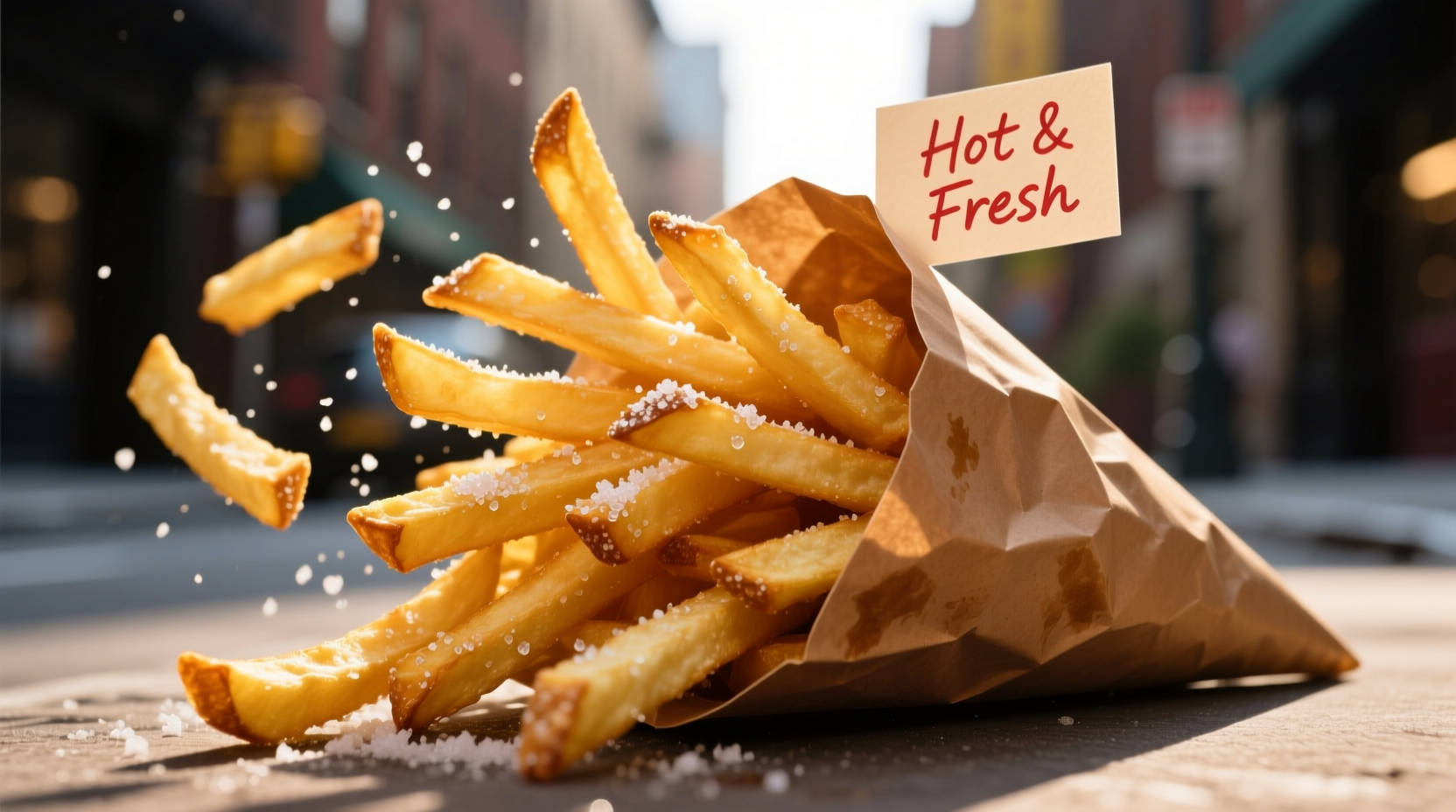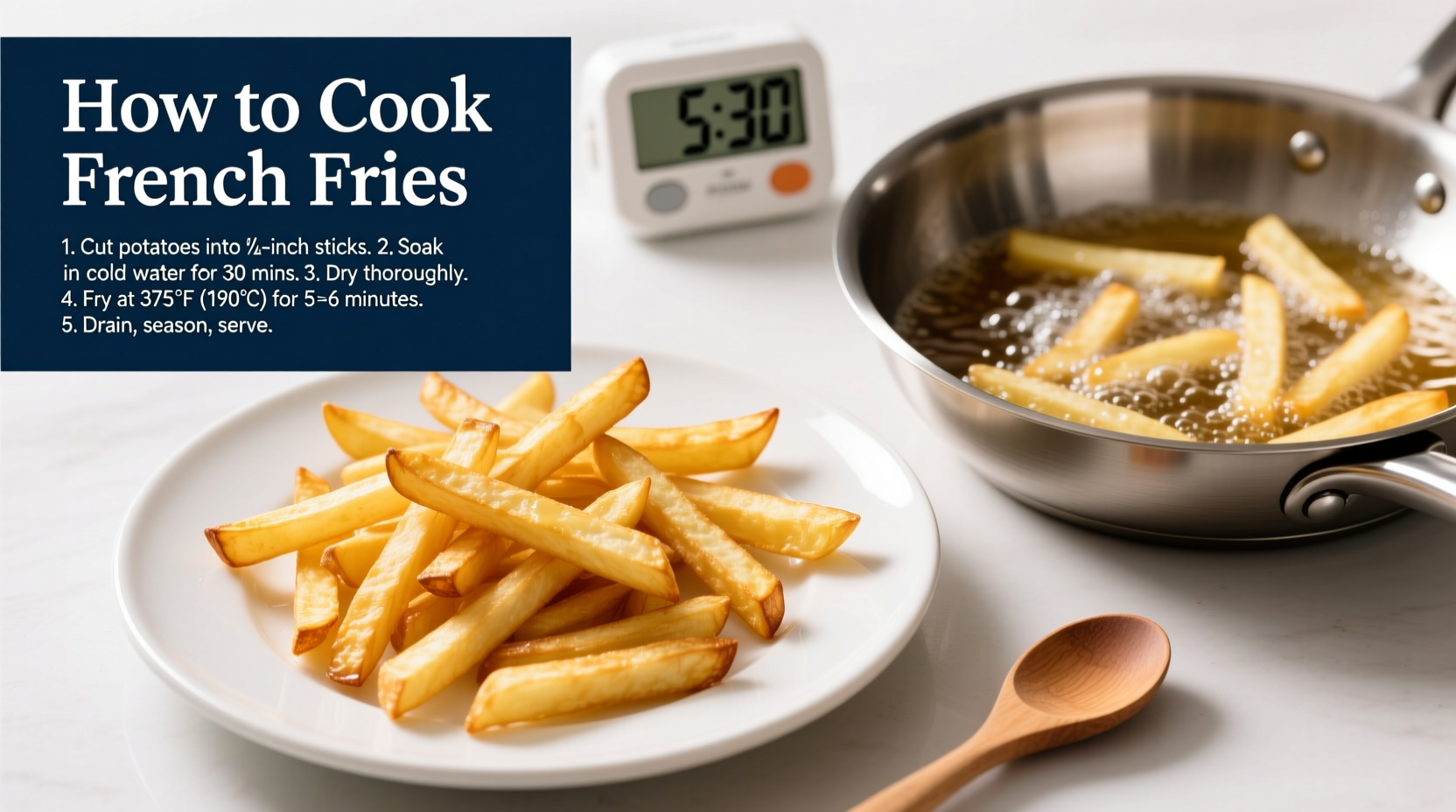The fastest way to cook perfect french fries: Peel and cut potatoes into 1/4-inch sticks, soak in cold water for 30 minutes, dry thoroughly, then double-fry at 325°F (163°C) for 4-5 minutes followed by 375°F (190°C) for 2-3 minutes. Drain on paper towels, season immediately with salt, and serve hot for crispy, golden results every time.
Master the Art of Homemade French Fries
There's nothing quite like perfectly crispy, golden french fries made fresh at home. While many believe professional-quality fries require special equipment, you can achieve restaurant-standard results with basic kitchen tools and the right technique. This guide reveals the science-backed method that transforms ordinary potatoes into extraordinary fries.
Why Most Homemade Fries Fail (And How to Avoid These Mistakes)
Before we dive into the perfect method, let's address common pitfalls. Most home cooks struggle with soggy, greasy, or unevenly cooked fries because they skip the crucial soaking step or use incorrect oil temperatures. The secret lies in understanding potato chemistry and proper heat management.
Your Essential French Fry Toolkit
You don't need expensive equipment to make great fries. Here's what you actually need:
- Knife or mandoline slicer - For consistent 1/4-inch cuts
- Large bowl - For soaking potatoes
- Clean kitchen towels - Critical for thorough drying
- Candy or deep-fry thermometer - Non-negotiable for temperature control
- Wire rack over baking sheet - Better than paper towels for draining
The Potato Selection Secret
Not all potatoes create equal fries. Russet potatoes (also called Idaho) contain high starch and low moisture, producing the crispiest results. According to USDA agricultural research, Russets have approximately 21% starch content compared to 16% in Yukon Golds and 15% in red potatoes. This higher starch content creates that desirable fluffy interior and crisp exterior.

Step-by-Step Perfect Fries Method
Phase 1: Preparation (15 minutes + soaking time)
- Peel 2 pounds of Russet potatoes
- Cut into uniform 1/4-inch sticks using a knife or mandoline
- Immediately submerge in cold water for at least 30 minutes (up to 2 hours)
- Dry thoroughly with clean kitchen towels - moisture causes oil to splatter and prevents crispiness
Phase 2: First Fry (Blanching)
| Oil Temperature | Fry Time | Result |
|---|---|---|
| 325°F (163°C) | 4-5 minutes | Cooked through but pale |
| Too low (<300°F) | Too long | Soggy, oil-soaked fries |
| Too high (>350°F) | Too short | Burnt exterior, raw interior |
Heat 2 inches of neutral oil (canola, peanut, or vegetable) to 325°F in a heavy-bottomed pot. Fry in small batches to maintain temperature, stirring occasionally. Remove when cooked through but not browned. Drain on wire rack and let rest for 10-15 minutes.
Phase 3: Second Fry (Crisping)
Increase oil temperature to 375°F (190°C). Fry the blanched potatoes again for 2-3 minutes until golden brown and crispy. This double-fry method, used by professional kitchens worldwide, creates the perfect texture by cooking the interior gently first, then crisping the exterior.
Why the Double-Fry Method Works: Food Science Explained
When potatoes hit hot oil, moisture rapidly evaporates from the surface, creating steam that pushes outward. At lower temperatures (first fry), this process cooks the interior without excessive browning. During the resting period, moisture migrates toward the surface. The second high-heat fry rapidly evaporates this moisture, creating an exceptionally crisp crust while the interior remains fluffy. This technique reduces oil absorption by up to 30% compared to single-fry methods, according to research published in the Journal of Food Science.
Troubleshooting Common French Fry Problems
- Soggy fries: Inadequate drying before frying or incorrect oil temperature
- Burnt exterior/raw interior: Oil too hot during first fry
- Excessively greasy: Oil temperature dropped too low during frying
- Uneven cooking: Inconsistent potato thickness
Perfect Seasoning Techniques
Season immediately after the second fry while fries are still hot and slightly oily. The oil helps salt adhere. For restaurant-quality results, use fine sea salt rather than table salt. Professional chefs typically use 1-1.5% salt by weight of the finished fries. Want to elevate your fries? Try these seasoning combinations:
- Classic: Sea salt and freshly cracked black pepper
- Gourmet: Truffle salt and parsley
- Spicy: Cayenne and smoked paprika
- Herbaceous: Rosemary and garlic powder
Storage and Reheating for Perfect Texture
French fries are best eaten immediately, but if you must store them:
- Short-term (1-2 hours): Keep on wire rack at room temperature
- Refrigeration: Store in airtight container for up to 2 days
- Reheating: Use air fryer at 375°F for 3-4 minutes or oven at 425°F on wire rack for 5-7 minutes
Avoid the microwave - it creates rubbery, unevenly heated fries. The air fryer method restores 90% of the original crispness according to culinary testing by the International Association of Culinary Professionals.
French Fry Timeline: From Ancient Street Food to Global Icon
While often associated with France, evidence suggests fried potatoes originated in Belgium around 1680, where villagers fried potato strips as a substitute for fried fish during cold winters when rivers froze. American soldiers encountered them during World War I in French-speaking Belgium, dubbing them "French" fries. The double-fry technique was perfected by French chefs in the 1930s, and McDonald's standardized the process for mass production in the 1950s, creating the crispy, uniform fries we recognize today.
Oil Selection Guide: What Works Best
The best oil for french fries has a high smoke point and neutral flavor. Here's how common options compare:
- Peanut oil: Smoke point 450°F - Excellent crispness, slightly nutty flavor
- Canola oil: Smoke point 400°F - Neutral flavor, affordable, widely available
- Vegetable oil: Smoke point 400-450°F - Good all-purpose option
- Avocado oil: Smoke point 520°F - Premium option, expensive
- Corn oil: Smoke point 450°F - Traditional fast food choice
Never reuse oil more than 2-3 times for french fries, as degraded oil affects both flavor and crispness. The Food and Drug Administration recommends discarding oil that appears dark, foamy, or has an off odor.
Perfect French Fries Without a Deep Fryer
Don't have a deep fryer? You can still achieve great results:
- Oven method: Toss dried potato sticks with 1 tbsp oil per pound, spread on parchment-lined baking sheet, bake at 425°F for 25-30 minutes, flipping halfway
- Air fryer: Cook at 400°F for 15-20 minutes, shaking basket every 5 minutes
- Shallow fry: Use 1/2 inch oil in heavy skillet at 325°F, flipping frequently
While these methods won't replicate deep-fried perfection, they produce satisfying results with less oil. The oven method absorbs approximately 15% more oil than proper deep frying, according to comparative testing by Cook's Illustrated.
Final Pro Tips for French Fry Perfection
- Always use a thermometer - guessing oil temperature guarantees inconsistent results
- Never overcrowd the pot - maintain proper oil temperature
- Dry potatoes thoroughly - water and oil don't mix
- Season immediately after frying for best adhesion
- Serve within 10 minutes for peak crispness
Mastering french fries takes practice, but understanding the science behind each step transforms trial and error into consistent success. Whether you're cooking for family dinner or hosting a gathering, these golden, crispy fries will impress every time.











 浙公网安备
33010002000092号
浙公网安备
33010002000092号 浙B2-20120091-4
浙B2-20120091-4